2015新版牛津译林英语七年级上册7AUnit3七年级上册Unit3全套英文教案
- 格式:pdf
- 大小:112.75 KB
- 文档页数:13
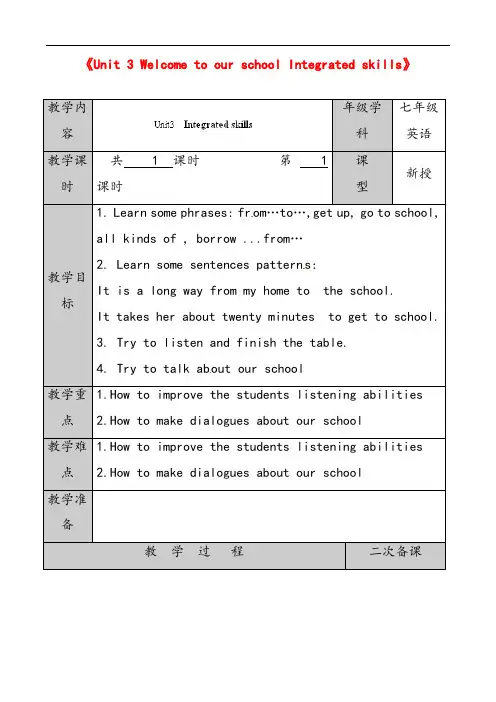
《Unit 3 Welcome to our school Integrated skills》教学内容年级学科七年级英语教学课时共 1 课时第 1课时课型新授教学目标1. Learn some phrases: fr om…to…,get up, go to school, all kinds of , borrow ...from…2. Learn some sentences patterns:It is a long way from my home to the school.It takes her about twenty minutes to get to school.3. Try to listen and finish the table.4. Try to talk about our school教学重点1.How to improve the students listening abilities2.How to make dialogues about our school教学难点1.How to improve the students listening abilities2.How to make dialogues about our school教学准备教学过程二次备课Step I Presentation1 Chat with students like this: How many classes do you have every day ? What ti me does your first class begin ?2 I get to school by bus every day. SometimesI ride a bike to school. Write “by bus &ridea bike on the blackboard. How do you get to school every day?3 If I go to school by bus, it takes me twenty minutes. How long does it take you to get to school by bike? Encourage students to answer with their own information.Step II Listening training.1Introduce Part A. Millie and her friends are talking about how they get to school every day . Now, let’s listen to their conversation and match the information with each person in Part A1.2 How does Millie get to school? What about Amy? How does Sandy get to school ?Then check the answers with them.3 Here is a table in Part2 . Would you please complete the table? Can you complete? If not.,Step II Listening drillsAmy’s cousin, Shirley, wants to know more about Amy’s school . Please listen to their conversation and answer this question: What place are they talking about? Encourage them to find the answer. They are talking about the library.Do some T/F exercise.(1)The library in Amy’s school is big .(T)(2) It is open from 9 a.m. to 5 p.m.(F)(3) The reading room is only open in the afternoon. (T)(4) There are many books in the library. (T)(5) Amy often borrows CDs from the library. (F) Step III PractiseStudents on the right play the role of Amy. Students on the left play the role of Shirley .Then we change the roles.Step IV ShowWould you like to introduce your own school? Do you have a library, a hall, an art room, a reading room or a music room? What do you know about these places ? What do you often do there ?Please work in pairs and make new conversations about your school.板书设计1.from…to 2.It takes sb. some time to do sth. 3.livenear our school 4.get to school5.be open from …to6. all kinds of7.borrow…from…教学反思。
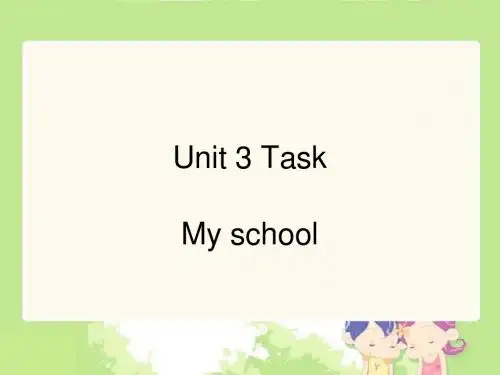
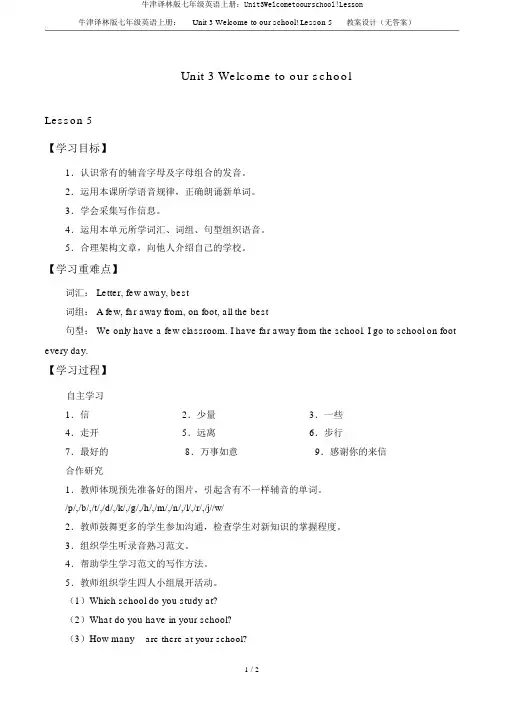
牛津译林版七年级英语上册:Unit 3 Welcome to our school! Lesson 5教案设计(无答案)Unit 3 Welcome to our schoolLesson 5【学习目标】1.认识常有的辅音字母及字母组合的发音。
2.运用本课所学语音规律,正确朗诵新单词。
3.学会采集写作信息。
4.运用本单元所学词汇、词组、句型组织语音。
5.合理架构文章,向他人介绍自己的学校。
【学习重难点】词汇: Letter, few away, best词组: A few, far away from, on foot, all the best句型: We only have a few classroom. I have far away from the school. I go to school on foot every day.【学习过程】自主学习1.信 _____________2.少量 _____________3.一些_____________4.走开 _____________ 5.远离 _____________6.步行_____________7.最好的 _____________ 8.万事如意_____________ 9.感谢你的来信_____________ 合作研究1.教师体现预先准备好的图片,引起含有不一样辅音的单词。
/p/,/b/,/t/,/d/,/k/,/g/,/h/,/m/,/n/,/l/,/r/,/j//w/2.教师鼓舞更多的学生参加沟通,检查学生对新知识的掌握程度。
3.组织学生听录音熟习范文。
4.帮助学生学习范文的写作方法。
5.教师组织学生四人小组展开活动。
(1)Which school do you study at?(2)What do you have in your school?(3)How many are there at your school?牛津译林版七年级英语上册:Unit 3 Welcome to our school! Lesson 5教案设计(无答案)(4) Is your playground big or small?(5)Are there any trees at your school?(6)Where do you live?【稳固练习】一、依据以下单词划线部分的发音,将其填在正确的分类中。
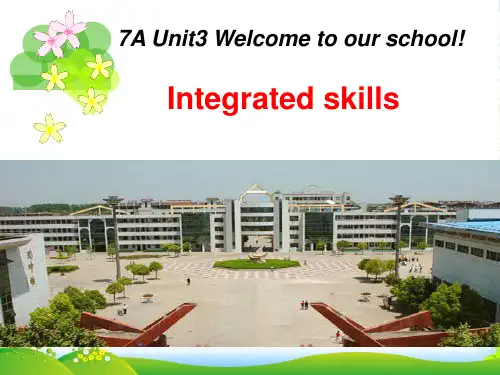
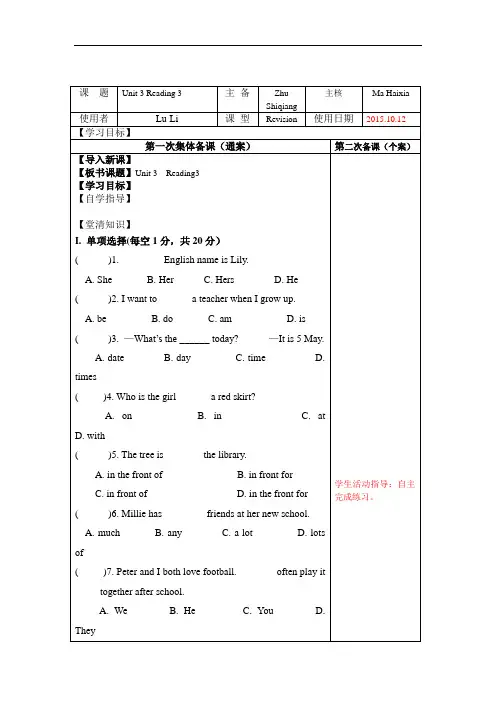
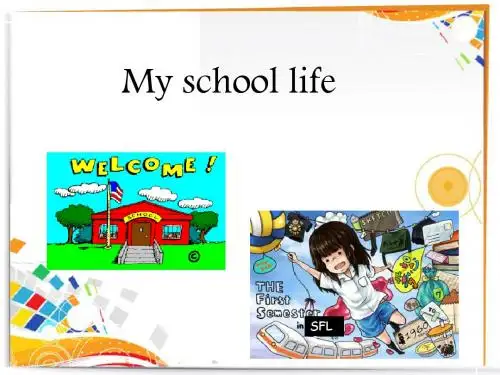
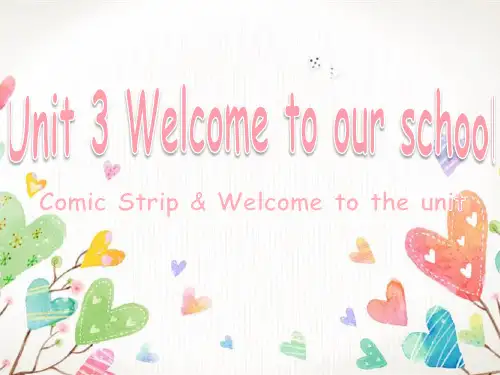
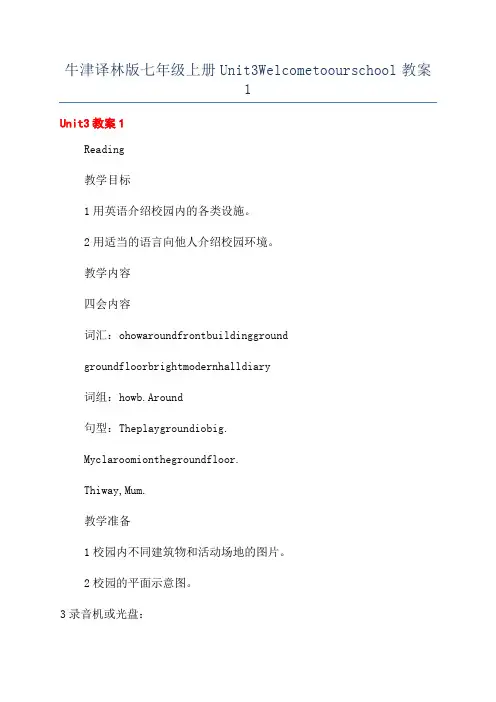
牛津译林版七年级上册Unit3Welcometoourschool教案1Unit3教案1Reading教学目标1用英语介绍校园内的各类设施。
2用适当的语言向他人介绍校园环境。
教学内容四会内容词汇:ohowaroundfrontbuildinggroundgroundfloorbrightmodernhalldiary词组:howb.Around句型:Theplaygroundiobig.Myclaroomionthegroundfloor.Thiway,Mum.教学准备1校园内不同建筑物和活动场地的图片。
2校园的平面示意图。
3录音机或光盘:4课件。
背景知识教学步骤StepI呈现1与学生就自己学校的情况进行交流,呈现新知识。
教师说:LookatourchoolIitbeautifulDoyoulikeit鼓励学生表达自己的真实观点。
教师说:Ithinkourchoolibeautiful.Itiogood.板书o。
接着问学生:Whatcanyoueeinthechool鼓励学生根据实际情况回答:Wecaneetalltree,beautifulflowerandaplayground.2教师接着向学生呈现事先准备好的校园图片。
教师说:Inourchool,wecanaloeeomebuilding.Lookatthibuilding.Sometalltreea reinfrontofit.板书building和infrontof。
教师呈现更多照片并说:What’infrontof…WhichbuildingiourclaroominWhichbuildingiourartr oominWhichbuildingiourchoolhallin板书hall,检验学生掌握的情况。
教师接着说:Lookatthibuilding.Howmanyfloorarethereinthebuilding和学生一起数:Let’count.One,two,three,four.Oh,therearefourfloorinthibuilding.指着一楼说:Thiithegroundfloor.Iourclaroomonthegroundfloor板书ground和onthegroundfloor,鼓励学生根据实际情况回答。
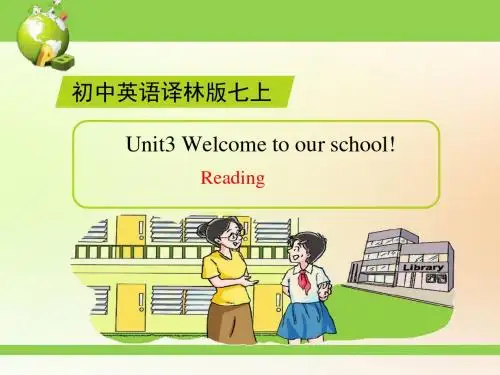
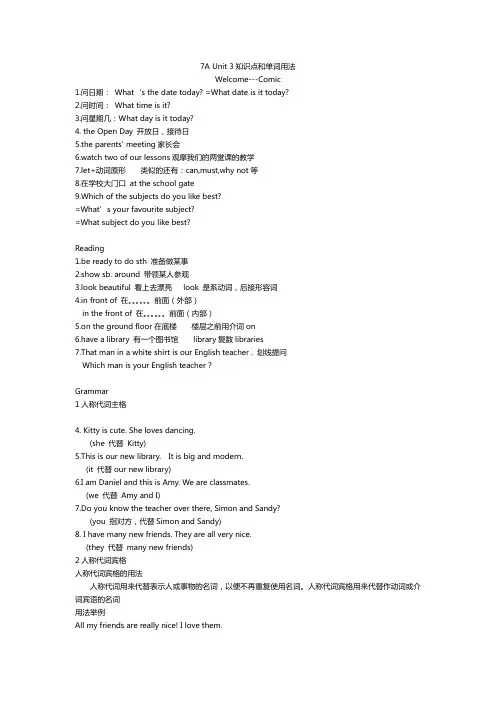
7A Unit 3知识点和单词用法Welcome---Comic1.问日期:What‘s the date today? =What date is it today?2.问时间:What time is it?3.问星期几:What day is it today?4. the Open Day 开放日,接待日5.the parents' meeting家长会6.watch two of our lessons观摩我们的两堂课的教学7.let+动词原形类似的还有:can,must,why not等8.在学校大门口at the school gate9.Which of the subjects do you like best?=What’s your favourite subject?=What subject do you like best?Reading1.be ready to do sth 准备做某事2.show sb. around 带领某人参观3.look beautiful 看上去漂亮look 是系动词,后接形容词4.in front of 在。
前面(外部)in the front of 在。
前面(内部)5.on the ground floor在底楼楼层之前用介词on6.have a library 有一个图书馆library复数libraries7.That man in a white shirt is our English teacher . 划线提问Which man is your English teacher?Grammar1人称代词主格4. Kitty is cute. She loves dancing.(she 代替Kitty)5.This is our new library. It is big and modern.(it 代替our new library)6.I am Daniel and this is Amy. We are classmates.(we 代替Amy and I)7.Do you know the teacher over there, Simon and Sandy?(you 指对方,代替Simon and Sandy)8. I have many new friends. They are all very nice.(they 代替many new friends)2人称代词宾格人称代词宾格的用法人称代词用来代替表示人或事物的名词,以便不再重复使用名词。
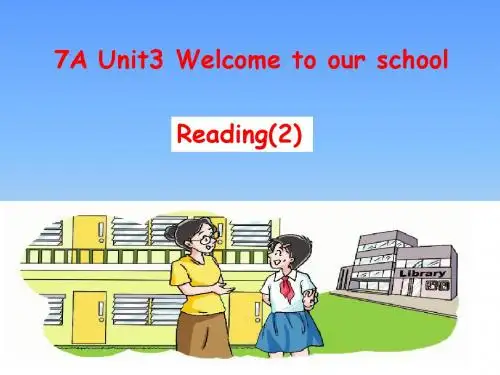
牛津英语7aunit3说课教学设计大家好,我叫….我说课的内容是《牛津英语》7AUNIT3LET'SCELEBRATEWELCOMETOTHEUNITCOMICSTRIP。
一.教材分析本课属于UNIT3LET'SCELEBRATE第1课时。
该单元通过介绍万圣节,让学生了解西方文化,培养学生学英语的兴趣,鼓励学生探索了解中西方文化差异,培养学生的爱国情操。
而本课时主要让学生能了解中外一些重要的节假日,节假日的背景及主要庆祝方式,能就有关“个人对节日的喜好”情况相互进行简单询问及回答,从而激发对本单元的学习兴趣,并初步培养自己的世界文化意识。
教学目标通过本课时的学习,发展学生的:1.知识技能:能听、说、读、写单词FESTIVAL,AS,DRESS,CELEBRATE,FAVOURITE,HALLOWEEN,GHOST,MOONCAKE并了解其含义。
短语DRESSUPAS,MID-AUTUMNFESTIVAL,DRAGONBOATFESTIVAL及句型WHICHISYOURFAVOURITEFESTIVAL?2.过程方法:使学生发展猜词句的含义,能就有关“个人对节日的喜好”情况相互进行简单询问及回答,培养学生总结、描述、阅读和综合语言运用能力。
3.情感态度价值观:了解中外一些重要的节假日及主要庆祝方式、培养学生对中外文化的理解能力,提高学生对中外文化异同的鉴别能力,培养学生的世界文化意识,增强学生对民族文化的自豪感。
教学重点:学习中外著名的节日。
初步了解庆祝这些节日的方式。
教学难点:根据图片猜测词义,讨论最喜欢的节日。
教学准备:课文录音、多媒体课件。
通过听录音,训练学生的听力能力。
多媒体课件调动学生的兴趣,丰富学生的视野。
二.教法学法.教法:针对本课的内容较多,对于学生现有的认知水平,采用启发式和导入式进行探究性学习。
学法:通过新旧知识比较法、讨论法和操练法,从而增加学习内容的趣味性,调动学生的学习兴趣,使全员参与,达到寓教于乐的效果。
7 A Unit 3 Welcome to our schoolThe first period: Comic strip& Welcome to the unitTeaching aims:( 1)、Learn some new words: “Which ,best ,so, biology ,geography ,history,Date ,meeting ,o’clock, OK ,gate”(2)、Learn some new phrases: School Open Day/ the parents’ meeting /at the school gate (3)、Learn some sentence patterns: Which of the subject do you like best?What’s the date today?/ What time is it?Importance & difficulty1.Talk with the simple present tense.2. How to master these new phrases.Teaching procedures:Step I Presentaion.In school, there are many subjects. What is your favourite one? Which is your favourite subject? My favourite subject is ….Step II PractiseWould you like to play a game to learn about your classmates’ favourite subjects? Let’s do chain work! Please ask the questions one by one.Sample conversationS1:Which of the subject do you like best?S2:I like …best.S1:Why?S2:Because it ….Which subject do you like best?S3:I like…best.S2:Why?S3:Because it….Step III Presentaion1The teacher asks:Eddie is a lovely dog. Do you know his favourite subject? Which is his favourite subject? Listen to the tape and answer this question.2 Act in pairs.3 Suppose you are Hobo. When you hear Eddie’s words, what do you think of him? What will you say to Eddie? Please continue writing Eddie and Hobo’s conversation.Step IV Presentaion1The teacher asks:You study at ….Middle School for many days. Do you like your new school? Do you tell your parents about your new school? What do you tell them? Students answer:I like my school. I tell my parents about classmates and sports.2The teacher says: I am teaching English now. So I am your English teacher. Who is this teacher?What subject does he/she teach? He/She teaches … Write “ biology ,geography, history”Step V PractiseFinish Part A and communicate with students.Step VI Activity1 The teacher asks: What’s the date today? What’s the date tomorrow ? What lessons do you have tomorrow?2 The teacher continue asks: What time is your Maths lesson? What time does your Chinese lesson begin? It begins at ….o’clock. Do you have a class meeting every week? Do you have a parents’ meeting? Some schools have an Open Day .It’s for parents to visit school. Do you have an Open Day? What’s the date of your Open Day ?Do you want an Open Day ? Would you like an Open Day ?3 Millie wants her mother to come to school on the Open Day .Please listen to the tape and answer these questions.(1) What’s the date of the Open Day in Millie’s school?(2) Can Millie’s mother go to her school?(3) What time does the parents’ meeting begin?(4) What else do parents’ do after the meeting?(5) Where does Millie meet her mother?Step VII Homework1.Recite the comics. 2 Do more practice.The second period: Reading(1)Teaching aims:(1)、learn some new words and expressions.(2)、learn some new phrases: show sb around /in front of(3)、learn some new sentences:The ground is so big./My classroom is on the ground floor. Teaching difficulty:How to introduce the facilities of our school.Teaching procedures:Step I Presentation.Look at our school. Is it beautiful? Do you like it? I think our school is beautiful. It is so good . What can you see in the school? We can see tall trees , beautiful flowers and a playground .In our school, we can also see some buildings. Look at this building. Some tall trees are infront of it . Which building is our classroom in ? Which building is our art room in? Which building is our school hall in ? Look at this building . How many floors are there in the building? Let’s count. One, two, three, four. Oh, there are four floors in this building . This is the ground. Is our classroom on the ground floor? Our classroom is on …floor. The classroom is so bright .We have a computer room too. It looks very modern.Step II PracticeOur school is a beautiful school. Today, some foreign visitors come to our school. Would you please look at the map and introduce our school to them?(1)There are …buildings in our school.(2) There are …floors in the building.(3) … is on the ground floor.(4) The classroom is ….(5) … is in front of…Step III Presentation1 Today is the Open Day in Millie’s school. Millie meets her mother at the school gate . She is ready to show her mother around the school.板书show sb around2 Here are some pictures of different places in Millie’s school. Let’s follow Millie to visit her school and know the places. “the playground ,the classroom building ,the classroom, the art room ,the music room, the computer room, the library and the hall.”3 Please read the conversation again. Then I’d like to check how well you know Millie’s school’4 Look at the information about Sunshine Middle School in Part B2. Read the conversation once more . Then write a T if the sentence is true. Write an F if it is false .Step IV Practice(1)Where do you meet today ?(2) How does Millie’s school look?(3) What about the playground /library?(4) How many classrooms are there in the classroom building?(5) Where is Millie’s classroom?(6) What do you think of Millie’s classroom?(7) What else is in her school?(8) Where do you have the meeting?....Step V ActivityRole-play time. Work in pairs and suppose you are Millie and her mother.Homework: Read the text after class and try to talk about our school.The third period: Reading (2)Teaching aims:(1)、learn some new words and expressions.(2)、learn some new phrases: show sb around /in front of(3)、learn some new sentences: The ground is so big./My classroom is on the ground floor. Teaching difficulty:How to introduce the facilities of our school fluently.Teaching procedures:Step I Presentation.Millie and her mother visit the school on the Open Day. Do you remember the places and people they see? Please arrange them in the order of time.Mr Wu the classroom building □ the school hall the art room and the music room the library Millie’s classroom(7,2,1,6,4,5,3,)2 Show sb around ,in front of , on the playground. Now, I will show you around in another school. It is not very big. It has only one classroom building and a small playground. There is a hall on the ground floor. There are five rooms in the school and they are all very bright. In every classroom, the students have computers in front of them. They can have lessons meetings on the Internet . It’s so modern.Step II Practice1 Millie wants to write a diary about her school. Can you help her complete the diary in Part B4?2 Millie’s pen friend Mike sends her an email from the UK. It’s about Mike’s school. Let’s read this email and complete it according to the Chinese.Dear Millie ,Thanks very much for your letter and the pictures of your school. Your school is ----------( 多么漂亮)。